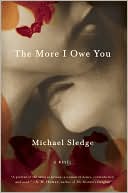 The Secret Dublin Diary of Gerard Manley Hopkins
The Secret Dublin Diary of Gerard Manley Hopkins
by Robert Waldron
Brandon. 149 pages, $18.95
The More I Owe You
by Michael Sledge
Counterpoint. 329 pages, $15.95
ROBERT WALDRON’S novella, The Secret Dublin Diary of Gerard Manley Hopkins, paints a brilliant and haunting portrait of a complicated man caught in the conflict between the spiritual and the sensual. An ordained Catholic priest, Hopkins was fascinated by beauty and was especially aware of male beauty. At times he felt attractions to male friends, which he both sentimentalized and spiritualized. Before entering the church, he met the precocious seventeen-year-old Digby Mackworth Dolben and fell head over heels in love with him. Sadly, Dolben drowned while teaching a friend’s son how to swim, and Hopkins was haunted by this loss for the rest of his days.
It was while a student at Oxford that Hopkins converted to Catholicism, causing a temporary split with his Anglican family. Later, after speaking with John Henry Newman, he joined the Society of Jesus, with which he continued his studies before being ordained as a Jesuit priest. He was eventually sent to Dublin to teach Greek at University College, traveling out of obedience to his Jesuit superiors and, in so doing, suffering the additional loss of being exiled from family, friends, and homeland.
Waldron’s novella is composed of Hopkins’ diary entries during his stay in Dublin, where he can give voice to the secret, forbidden desires with which he has always wrestled. Early on, while taking in the city, he spots a student “lying naked to the waist in the sun-drenched grass.” Rather than reprimand the student for his lack of modesty as dictated by the rules of the college, Hopkins drinks in the view, longing to reach out and touch the young man. Far away from home in a strange land, he desperately desires a human connection. Shortly afterwards, however, he catches himself, realizing that he’s forgetting one of the cardinal rules of his order, custodia occulorum, or custody of the eyes, and is immediately overwhelmed by guilt. This scene repeats itself frequently throughout the story: Hopkins’ longings conflicting with society’s sexual norms and the Jesuits’ specific regulations.
Hopkins develops a close friendship with a fellow priest, Brother John, which brings joy to his barren existence and helps him survive his time in Dublin. Another custom of the Jesuits was to avoid “particular friendships” or close associations with one individual. Hopkins quickly realizes that his attraction to Brother John is growing with each day and that he’s involved in a particular friendship. He considers ending it but rationalizes the situation and continues it. Still, he burns with guilt. Another priest recognizes the close attachment between Brother John and Hopkins and secretly delivers a series of hateful notes under the door of his room during the night, adding to his torment.
Brother John eventually falls ill and returns home, which only increases Hopkins’ feelings of guilt, as he now feels responsible for his friend’s condition. John recovers enough for Hopkins to visit him, and during their conversation Hopkins reveals his interest in the poetry of Walt Whitman. John is scandalized due to Whitman’s thinly concealed homoeroticism, and Hopkins realizes that he has probably revealed too much. The Secret Dublin Diary lovingly depicts the conflict of a gifted poet who struggles to love and accept himself, battling religious and cultural homophobia and its internalized manifestations. Hopkins’ story is one that many gay people will easily recognize.
In The More I Owe You, Michael Sledge ingeniously imagines the life of poet Elizabeth Bishop and her lover, socialite and architect Lota de Macedo Soares, while they were living together in Brazil during the 1950’s and 60’s. Drawing on Bishop’s surviving letters, journals, and drafts from poems, this debut novel explores the couple’s tumultuous, tragically short relationship. The novel covers a time when both women struggled with their demons even while reaching the heights of their respective professions: Bishop won the Pulitzer Prize in 1956, and Soares rose to prominence in Rio de Janeiro’s turbulent political landscape.
Although the casual reader picking up this novel may not know the facts of Bishop’s life, Sledge deftly weaves the background information into his story, helping to explain her damaged psyche and her sometimes self-destructive behavior. Her father passed away when she was an infant, and when she was five her mentally unbalanced mother was permanently committed to a sanitarium. After shuttling between Nova Scotia, where she lived with her grandparents, and the suburbs of Boston, where she stayed with an aunt, Bishop entered Vassar in 1930. There the college librarian arranged for her to meet Marianne Moore. Bishop’s first book of poems, North & South, appeared in 1946, when she was 35, after it had been rejected by a number of publishing houses.
In 1951, needing a change of air, Bishop set sail for Brazil. Her recent stay at Yaddo, the artists’ community in upstate New York, had been a disaster of alcohol and procrastination, and she was racked by too little writing, too much drinking, and unhealthy doses of self-recrimination. Once in Rio, Bishop is soon whisked off to Soares’ home near Petropolis, in the hills. She eats the yellow-orange fruit of the cashew, falls ill from a severe allergic reaction, and is nursed back to health and poetic productivity by Soares, now her lover, who invites her to share the enormous glass house she has been building on the side of a cliff.
After a brief period of bliss, however, life becomes difficult for these two gifted women. Soares’ ceaseless motion and seemingly endless projects, stemming from desperation, heighten Bishop’s chronic anxiety, which she remedies by drinking herself numb. Early on, the reader sees the indelible image of a brilliant, tormented woman writing tirelessly through the tropic night by the light of a kerosene lamp, her creativity fueled by “an injection of cortisone (for asthma) plus two cc’s of adrenaline, a whiff of norisodrine sulphate, and a blast of gin and tonic.” This dependency is the source of many of the two women’s arguments, which resulted in several brief separations.
The More I Owe You is full of beautiful details: the stones in the jungle, the cruelties of drunkenness, the beauty and passion of love-making. It artfully evokes Brazil’s primeval rural landscape and uniquely urbane Rio, a strange combination of jungle and 20th-century megalopolis. Yet there are times when Soares comes across as a stereotypically passionate, emotional Latina, making it difficult to see the real woman who constructs a grand municipal park in Rio, fighting the complexities of the Brazilian bureaucracy to achieve it, at the cost of her physical and mental health. Her portrayal also makes it hard to see why she would later commit suicide by vindictively swallowing too many sleeping pills the night after her arrival at Bishop’s borrowed apartment in New York. And despite the conservative temperament of the period, no one makes any unkind remarks about the relationship between these two women.
The More I Owe You enchants. On New Year’s Day in 1968, Bishop, now living in San Francisco, buys as many white flowers as her arms can hold and wades into the Pacific Ocean, dropping the blossoms, one at a time, into the water. They disappear, caught up by the current that pulls at her feet. But, as the novel closes, Bishop remains standing, a pillar of determination, control, and resilience.
Charles Green is a write based in Annapolis, Maryland.





